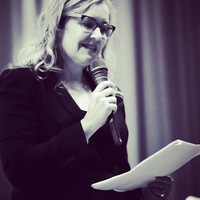Papers by Dr Osman Latiff

Landscaping otherness and challenging frames of ‘nothingness’ in contemporary Palestine
Space and Polity, Sep 1, 2016
Discerning modes of syncretic attitudes in the narratives of US anti-war advocates in Palestine a... more Discerning modes of syncretic attitudes in the narratives of US anti-war advocates in Palestine allow us to consider ways in which temporalities of Self and Other are constructed and importantly, altered. By drawing on the diary account of activist Rachel Corrie and presentation of American ultra-marathoners in Palestine who are placed in a ‘rescue’ typeset I will consider the way meanings of self are interplayed with perceptions of otherness and how empathetic responses find their way into challenging existing states. We consider the ways that the activists sought to open up global spaces to develop ‘a sense of there being an elsewhere'. It is within this ‘elsewhere’ that actors identify sites of meaning and importance to their ‘others’. I propose in this essay that the sites used for the planting of olive trees and sites of meaning in their run act as intersection points between the American activists and Palestinians that syncretise spaces and identities. Codes of familiarity in landscapes together with participatory actions provide a medium for attachment ‘at the human level’ and can challenge pre-existing attitudes of otherness.
Poeticising the Reconquest and Future Expectations
In The Cutting Edge of the Poet’s Sword Osman Latiff assesses anti-Frankish Muslim poetry during ... more In The Cutting Edge of the Poet’s Sword Osman Latiff assesses anti-Frankish Muslim poetry during the crusades, specifically the topic of faḍāʾil al-Quds (‘merits of Jerusalem’) and jihād as they relate to the occupation and reconquest of Jerusalem.
Appendix: Arabic Poems
In The Cutting Edge of the Poet’s Sword Osman Latiff assesses anti-Frankish Muslim poetry during ... more In The Cutting Edge of the Poet’s Sword Osman Latiff assesses anti-Frankish Muslim poetry during the crusades, specifically the topic of faḍāʾil al-Quds (‘merits of Jerusalem’) and jihād as they relate to the occupation and reconquest of Jerusalem.
Theories and Principles of Jihād and the Quest for Martyrdom
In The Cutting Edge of the Poet’s Sword Osman Latiff assesses anti-Frankish Muslim poetry during ... more In The Cutting Edge of the Poet’s Sword Osman Latiff assesses anti-Frankish Muslim poetry during the crusades, specifically the topic of faḍāʾil al-Quds (‘merits of Jerusalem’) and jihād as they relate to the occupation and reconquest of Jerusalem.
Index of Names and Places
In The Cutting Edge of the Poet’s Sword Osman Latiff assesses anti-Frankish Muslim poetry during ... more In The Cutting Edge of the Poet’s Sword Osman Latiff assesses anti-Frankish Muslim poetry during the crusades, specifically the topic of faḍāʾil al-Quds (‘merits of Jerusalem’) and jihād as they relate to the occupation and reconquest of Jerusalem.
The Place of Egypt in Poetic Discourse
In The Cutting Edge of the Poet’s Sword Osman Latiff assesses anti-Frankish Muslim poetry during ... more In The Cutting Edge of the Poet’s Sword Osman Latiff assesses anti-Frankish Muslim poetry during the crusades, specifically the topic of faḍāʾil al-Quds (‘merits of Jerusalem’) and jihād as they relate to the occupation and reconquest of Jerusalem.
Introduction: Setting the Scene
In The Cutting Edge of the Poet’s Sword Osman Latiff assesses anti-Frankish Muslim poetry during ... more In The Cutting Edge of the Poet’s Sword Osman Latiff assesses anti-Frankish Muslim poetry during the crusades, specifically the topic of faḍāʾil al-Quds (‘merits of Jerusalem’) and jihād as they relate to the occupation and reconquest of Jerusalem.
Springer eBooks, 2021
This chapter places the discourse of empathy in the context of media marginalisation of the killi... more This chapter places the discourse of empathy in the context of media marginalisation of the killings of 14 year old Abeer Hamza Qasim al-Janabi and her family on March 12, 2006, in the town of Mahmudiyah, Iraq, by American servicemen. An assessment of newspaper reports of the killings sheds light on ways in which the story became situated in American news media as one entangled in a frame of chaos and disorder. This frame represented the War in Iraq and Iraq generally, precluding the creation of an empathic news model. The chapter considers the place of photography in the reporting of the news-story and examines ways in which mediated responses to visual framing force us to re-question and reconsider questions of identity and otherness.

Landscaping ‘Otherness and Challenging Frames of “Nothingness” in Contemporary Palestine’
Springer eBooks, 2021
Discerning modes of syncretic attitudes in the narratives of US anti-war advocates in Palestine a... more Discerning modes of syncretic attitudes in the narratives of US anti-war advocates in Palestine allow us to consider ways in which temporalities of Self and Other are constructed and importantly, altered. By drawing on the diary account of activist Rachel Corrie and presentation of American ultra-marathoners in Palestine who are placed in a ‘rescue’ typeset I will consider the way meanings of self are interplayed with perceptions of otherness and how empathetic responses find their way into challenging existing states. We consider the ways that the activists sought to open up global spaces to develop ‘a sense of there being an elsewhere’. It is within this ‘elsewhere’ that actors identify sites of meaning and importance to their ‘others’. I propose in this essay that the sites used for the planting of olive trees and sites of meaning in their run act as intersection points between the American activists and Palestinians that syncretise spaces and identities. Codes of familiarity in landscapes together with participatory actions provide a medium for attachment ‘at the human level’ and can challenge pre-existing attitudes of otherness.
Performance and Pathos: Symbolism of Suffering in the Mourning of Iraqi ‘Mothers’
Springer eBooks, 2021
In this chapter, ‘Performance and Pathos: Symbolism of Suffering in the Mourning of Iraqi “mother... more In this chapter, ‘Performance and Pathos: Symbolism of Suffering in the Mourning of Iraqi “mothers”’ assesses symbolism of suffering and mourning in a performance ritual of twenty-three international performance artists whose purpose was to honour the dead and wounded civilians of Iraq. The chapter highlights ways in which anti-war activists utilised the visual appeal of performance to give legitimacy to the process of grieving and mourning in a context that coalesces a Middle Eastern/Islamic dimension with a Western one. The chapter considers the creation of a new spatiality with a procession that is both ‘inside’ and ‘outside’ the West, and the ways in which cultural codes of performance and activism might bridge the cultural gap between activist, target and audience.

Empathy Behind and Beyond the Cage
Springer eBooks, 2021
This chapter, ‘Empathy Behind and Beyond the Cage’, presents a very important though overlooked c... more This chapter, ‘Empathy Behind and Beyond the Cage’, presents a very important though overlooked case in the War on Terror in Iraq; the tragedy witnessed by and involving an intelligence officer of the 101st Airborne unit in Iraq, Alyssa Peterson. Peterson was troubled by what she witnessed of interrogation methods meted out to Iraqi prisoners in a unit named ‘The Cage’. The chapter delineates formations and consequences of attitudes towards distant, orientalised enemy ‘others’. Reliant on the testimony of colleague, Kayla Williams, the chapter seeks to make sense of binaries between torturer and prisoner and ways in which empathic outlooks towards the distressed can open new spaces of building empathy. The second section of the chapter is a symptomatic interpretation of Peter Sattler’s American independent drama film Camp X-Ray (2014) analysing the film’s formalist and exponential elements which draw on empathic imagery in light of American and Arab identities.
A Paradigm of Pious <i>Jihād</i> in the Muslim Ethos
Cambridge University Press eBooks, May 31, 2023

Distance as Othering: US Images of Conflict Inside and Outside the Homeland
Springer eBooks, 2021
Further to delineations of empathy in landscaping, this chapter, ‘Distance as Othering: US images... more Further to delineations of empathy in landscaping, this chapter, ‘Distance as Othering: US images of Conflict inside and outside the Homeland’, considers the discourse of space, media and politics in relation to perceptions of human suffering inside and outside the (U.S) homeland. Drawing on ‘collectivism framing’ analysis, the chapter considers the reflective nature of icons of suffering. It explores what these icons surmise of projected ideas about grief and mourning, and how their media framing is associated with self-identity. In the U.S, the visual ‘collectivism frame’ is a master frame in media framing of victims and public grieving. The chapter will draw on contrasting visual codes in the framing of other victims outside the homeland. Instead of comparing visual representations of loss and grieving as a result of the War in Iraq, this article will consider the dominance of ‘collectivism’ framing in media representations of the Virginia Tech school shooting (2007) ‘inside’ the U.S, and compare this with media framing of ‘outside’ Iraqi victims of the War in Iraq (2003–present).
Cover illustration: Image from an eighth-/fourteenth-century Mamluk manuscript from the British L... more Cover illustration: Image from an eighth-/fourteenth-century Mamluk manuscript from the British Library's collection of Arabic manuscripts: Nihāyat al-sūʾl wa-l-umniyya fī taʿallum aʿmāl al-furūsiyya ("An end of questioning and desiring [further knowledge] concerning learning of the different exercises of horsemanship"). The Arabic text to the right of the image states that it is an 'Illustration of a horseman with the edge of the sword under his right arm, the hilt in his left with the reins.' (Add. MS. 18866, fol. 127r).
Shattered Dreams: Jerusalem, the Umma, and New Enemies
In The Cutting Edge of the Poet’s Sword Osman Latiff assesses anti-Frankish Muslim poetry during ... more In The Cutting Edge of the Poet’s Sword Osman Latiff assesses anti-Frankish Muslim poetry during the crusades, specifically the topic of faḍāʾil al-Quds (‘merits of Jerusalem’) and jihād as they relate to the occupation and reconquest of Jerusalem.

Empathy and the Search for the Other
Springer eBooks, 2021
This chapter of the book, ‘Empathy and the Search for the Other’, considers parameters of empathy... more This chapter of the book, ‘Empathy and the Search for the Other’, considers parameters of empathy as empathic action. The chapter frames the book’s contents, as deriving from and relevant to empathic outlooks. It outlines an array of scholarly opinion on empathy which determines it as a cognitive response to others, and separate from the emotive spontaneity of sympathy; and ways in which empathy is formed with respect to self and other or audience and target perceptions and relations. Drawing on anecdotal testimonies in the works of Tzvetan Todorov and Timothy Snyder, the chapter underscores the important place of imagined storying in empathic discourse; it draws on the diary testimony of Kazimierz Sakowicz’s “Ponary Diary”, of a ‘silent empathy’ which has hallmarks of ‘witnessing’ through risk-taking for a Lithuanian journalist in the Holocaust. The chapter deliberates on the social conditions which facilitate empathic outlooks with reference to examples of reconciliation bearing in South Africa and conversely, impediments which restrict and complicate the onset of empathy.
The place of Fasda'il Al-Quds (merits of Jerusalem) : literature and religious poetry in the Muslim effort to recapture Jerusalem during The Crusades
EThOS - Electronic Theses Online ServiceGBUnited Kingdo
Navigating War, Dissent and Empathy in Arab/U.S Relations: Seeing Our Others in Darkened Spaces
Poetry and Poetics in Medieval Arabic Discourse
The Cutting Edge of the Poet’s Sword: Muslim Poetic Responses to the Crusades, 2018
In The Cutting Edge of the Poet’s Sword Osman Latiff assesses anti-Frankish Muslim poetry during ... more In The Cutting Edge of the Poet’s Sword Osman Latiff assesses anti-Frankish Muslim poetry during the crusades, specifically the topic of faḍāʾil al-Quds (‘merits of Jerusalem’) and jihād as they relate to the occupation and reconquest of Jerusalem.
Theories and Principles of Jihād and the Quest for Martyrdom
The Cutting Edge of the Poet’s Sword: Muslim Poetic Responses to the Crusades, 2018
In The Cutting Edge of the Poet’s Sword Osman Latiff assesses anti-Frankish Muslim poetry during ... more In The Cutting Edge of the Poet’s Sword Osman Latiff assesses anti-Frankish Muslim poetry during the crusades, specifically the topic of faḍāʾil al-Quds (‘merits of Jerusalem’) and jihād as they relate to the occupation and reconquest of Jerusalem.











Uploads
Papers by Dr Osman Latiff
Numerous, varied, historical and contemporary examples are used from many different fields to demonstrate key points throughout the book, giving the reader a glimpse into the depth and breadth of history, literature, spirituality, conflict studies and how these concepts have manifested themselves across all these fields in relation to discourses of othering, dehumanisation and empathy. This book calls on us to attempt to see one another without the stereotypes, the walls, the distance both physical and cultural, that mar our perceptions of each other. Inspired by the Prophetic empathy, the book provides guidelines on bridging between communities and suggests direct lessons for the reader to take.